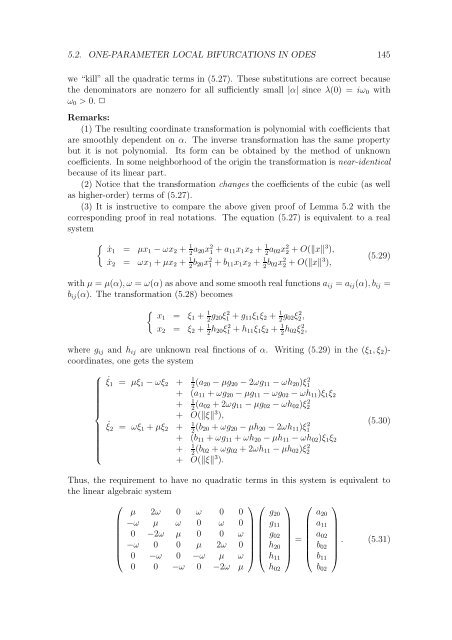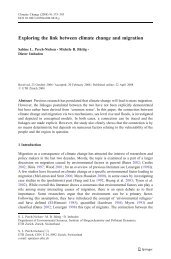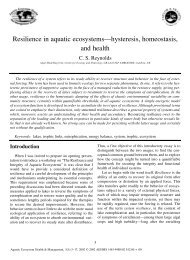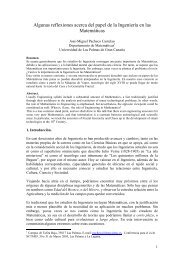5.2.2 Planar Andronov-Hopf bifurcation
5.2.2 Planar Andronov-Hopf bifurcation
5.2.2 Planar Andronov-Hopf bifurcation
Create successful ePaper yourself
Turn your PDF publications into a flip-book with our unique Google optimized e-Paper software.
5.2. ONE-PARAMETER LOCAL BIFURCATIONS IN ODES 145<br />
we “kill” all the quadratic terms in (5.27). These substitutions are correct because<br />
the denominators are nonzero for all sufficiently small |α| since λ(0) = iω 0 with<br />
ω 0 > 0. ✷<br />
Remarks:<br />
(1) The resulting coordinate transformation is polynomial with coefficients that<br />
are smoothly dependent on α. The inverse transformation has the same property<br />
but it is not polynomial. Its form can be obtained by the method of unknown<br />
coefficients. In some neighborhood of the origin the transformation is near-identical<br />
because of its linear part.<br />
(2) Notice that the transformation changes the coefficients of the cubic (as well<br />
as higher-order) terms of (5.27).<br />
(3) It is instructive to compare the above given proof of Lemma 5.2 with the<br />
corresponding proof in real notations. The equation (5.27) is equivalent to a real<br />
system<br />
{<br />
ẋ1 = µx 1 − ωx 2 + 1 2 a 20x 2 1 + a 11x 1 x 2 + 1 2 a 02x 2 2 + O(‖x‖3 ),<br />
ẋ 2 = ωx 1 + µx 2 + 1 2 b 20x 2 1 + b 11x 1 x 2 + 1 2 b 02x 2 2 + O(‖x‖3 ),<br />
(5.29)<br />
with µ = µ(α), ω = ω(α) as above and some smooth real functions a ij = a ij (α), b ij =<br />
b ij (α). The transformation (5.28) becomes<br />
{<br />
x1 = ξ 1 + 1 2 g 20ξ 2 1 + g 11 ξ 1 ξ 2 + 1 2 g 02ξ 2 2,<br />
x 2 = ξ 2 + 1 2 h 20ξ 2 1 + h 11 ξ 1 ξ 2 + 1 2 h 02ξ 2 2,<br />
where g ij and h ij are unknown real finctions of α. Writing (5.29) in the (ξ 1 , ξ 2 )-<br />
coordinates, one gets the system<br />
⎧<br />
⎪⎨<br />
⎪⎩<br />
˙ξ 1 = µξ 1 − ωξ 2 + 1(a 2 20 − µg 20 − 2ωg 11 − ωh 20 )ξ1<br />
2<br />
+ (a 11 + ωg 20 − µg 11 − ωg 02 − ωh 11 )ξ 1 ξ 2<br />
+ 1(a 2 02 + 2ωg 11 − µg 02 − ωh 02 )ξ2<br />
2<br />
+ O(‖ξ‖ 3 ),<br />
˙ξ 2 = ωξ 1 + µξ 2 + 1(b 2 20 + ωg 20 − µh 20 − 2ωh 11 )ξ1<br />
2<br />
+ (b 11 + ωg 11 + ωh 20 − µh 11 − ωh 02 )ξ 1 ξ 2<br />
+ 1(b 2 02 + ωg 02 + 2ωh 11 − µh 02 )ξ2<br />
2<br />
+ O(‖ξ‖ 3 ).<br />
(5.30)<br />
Thus, the requirement to have no quadratic terms in this system is equivalent to<br />
the linear algebraic system<br />
⎛<br />
⎜<br />
⎝<br />
µ 2ω 0 ω 0 0<br />
−ω µ ω 0 ω 0<br />
0 −2ω µ 0 0 ω<br />
−ω 0 0 µ 2ω 0<br />
0 −ω 0 −ω µ ω<br />
0 0 −ω 0 −2ω µ<br />
⎞ ⎛<br />
⎟ ⎜<br />
⎠ ⎝<br />
⎞<br />
g 20<br />
g 11<br />
g 02<br />
h 20<br />
⎟<br />
h 11<br />
⎠<br />
h 02<br />
⎛<br />
=<br />
⎜<br />
⎝<br />
a 20<br />
a 11<br />
a 02<br />
b 02<br />
b 11<br />
b 02<br />
⎞<br />
. (5.31)<br />
⎟<br />
⎠






